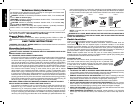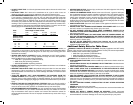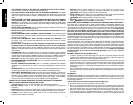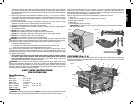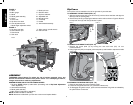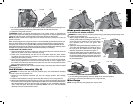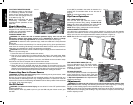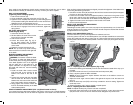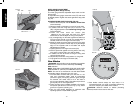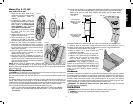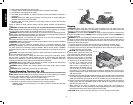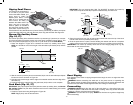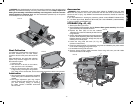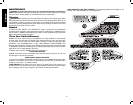
10
English
MITER GAUGE ADJUSTMENT
(Calibrating Miter Gauge Pointer)
Your miter gauge features adjustable stops at 90° and 45°
left and right.
To adjust the miter gauge, loosen the screw (TT) and move
to desired position. Tighten the screw against the stop plate
(Fig. 24).
ALIGNING RIVING KNIFE TO BLADE (FIG. 25)
1. Remove the throat plate. See To Remove Throat Plate
under Assembly.
2. Raise the blade to full depth of cut and 0° bevel angle.
3. If needed, raise the riving knife (FF) to the thru - cut
(ZZ) or highest position. See Positioning Riving Knife
under Assembly.
4. Locate the three small set screws (A2)
adjacent to the riving knife lock knob (YY). These
screws will be used to adjust the riving knife position.
5. Lay a straight edge on the table against two blade tips.
The riving knife should not touch the straight edge. If
needed, loosen the two larger lock screws (A3).
6. Adjust the small set screws (A2) to move the riving knife
according to the position noted in step 5. Lay the straight
edge on the opposite side of the blade and repeat
adjustments as needed.
7. Lightly tighten the two larger lock screws (A3).
8. Place a square flat against the riving knife to the verify
riving knife is vertical and in-line with the blade.
9. If needed, use the set screws to bring the riving knife
vertical with the square.
10. Repeat steps 5 and 6 to verify position of riving knife.
11. Fully tighten the two larger lock screws (A3).
Saw Blades
WARNING: Riving knifes must be matched to saw blade
dimensions in order to function effectively. See Riving
Knife selection.
NOTE: THIS SAW IS INTENDED FOR USE ONLY WITH
SAW BLADES 10" (254 mm) IN DIAMETER. See Fig. 26.
NOTE: This saw is not intended for use with dado blades
and molding cutters. Personal injury may occur.
1. The saw blade furnished with your new saw is a 10"
(254 mm) combination blade, used for crosscutting
(across the grain) and ripping (with the grain) through
the material. The center hole to fit on the arbor is
5/8" (16 mm) diameter (.625"). This blade will produce a
good quality cut for most applications.
2. There are many types of blades available to do specific
and special jobs such as cross cut only, rip only, hollow
ground, thin plywood, paneling, etc.
3. Use only saw blades designed for maximum safe
operating speeds of 5,000 RPM or greater.
FIG. 23
FIG. 22
QQ
SS
RR
J
FIG. 24
TT
FIG. 25
A1
ZZ
A2
A3
YY
FF
FIG. 26
4. Saw blades should always be kept sharp. It is
recommended that you locate a reputable sharpening
service to sharpen your blades when needed.
CAUTION: Abrasive wheels or blades (including
diamond) should not be used on this saw.



